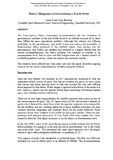- CERES Home
- →
- School of Engineering (SoE)
- →
- Staff publications (SoE)
- →
- View Item
JavaScript is disabled for your browser. Some features of this site may not work without it.
| dc.contributor.author | Todd, Laura | en_UK |
| dc.contributor.author | Bowling, Tom | en_UK |
| dc.date.accessioned | 2005-11-22T13:33:56Z | |
| dc.date.available | 2005-11-22T13:33:56Z | |
| dc.date.issued | 2004-12-18T11:04:06Z | en_UK |
| dc.identifier.uri | http://hdl.handle.net/1826/789 | |
| dc.description | Paper presented at Dynamics and Control of Systems and Structures in Space (DCSSS), 6th conference, Riomaggiore, Italy, July 2004 | en_UK |
| dc.description.abstract | The Inter-Agency Debris Committee recommendation for the reorbiting of geostationary satellites at the end of life involves an altitude increase of no more than 300km for most operational satellites. Although this reduces the collision probability in the geostationary ring itself, it does not remove the possibility of fragmentation debris produced in the reorbital region from passing into the geostationary ring. Unless the satellites are reorbited to a higher altitude than the current recommendations, the debris problem will continue to escalate to an unmanageable level. Due to mass and fuel budgets there are a limited number of available propulsive options, which can achieve the necessary reorbit. The research focus selected has been solar sails and this paper describes ongoing research for the reorbit of geostationary satellites using this method. | en_UK |
| dc.format.extent | 1883 bytes | |
| dc.format.extent | 233707 bytes | |
| dc.format.mimetype | text/plain | |
| dc.format.mimetype | application/pdf | |
| dc.language.iso | en_UK | en_UK |
| dc.publisher | Cranfield University; School of Engineering | en_UK |
| dc.title | Debris mitigation in geostationary earth orbit | en_UK |
| dc.type | Presentation | en_UK |
Files in this item
This item appears in the following Collection(s)
-
Staff publications (SoE) [603]
